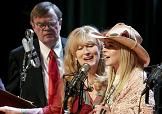 She was the Simon Cowell of “America’s Next Top Model“–the judge who everyone hated but whose acerbic, insensitive responses were a central reason for high ratings. Then on “The Surreal Life,” she clashed with “The Apprentice’s” Omarosa, to the glee of the celebrity-meltdown-watching audience. Now, Janice Dickinson has her own modeling agency, and a reality series about having her own modeling agency.
She was the Simon Cowell of “America’s Next Top Model“–the judge who everyone hated but whose acerbic, insensitive responses were a central reason for high ratings. Then on “The Surreal Life,” she clashed with “The Apprentice’s” Omarosa, to the glee of the celebrity-meltdown-watching audience. Now, Janice Dickinson has her own modeling agency, and a reality series about having her own modeling agency.
The show premiered June 6, with new episodes airing Tuesdays at 10. And per the manner of most “reality” shows, it’s hard to know which idea came first, the show or the agency.
Having herself overcome obstacles that threatened to prevent her own modeling career from developing–and then becoming “the world’s first supermodel”–Janice feels qualified to take the “raw material” of these wannabe models and breathe life into them. “I can see a model that the model doesn’t even know that they’re a model,” she says in the second episode. The result is that her agency/show isn’t just a conduit for modeling jobs: It’s part Janice as Creator/Deity Filling the Earth With Models, and part The Janice Dickinson College for Pretty People.
But why would we want to watch? We value beauty and fashion, which models professionally (and literally) embody, but, on some visceral level, we also want to see them bleed. Because they make a living promoting unattainable standards of beauty, we need to see them destroyed. So when Janice yells at one of the models for not having buffed her fingers (“your cuticles look like Martha Stewart on crack”), and tells another that she is too fat (“you need to do some shrinkage or go for a plus-size look”), we feel a mix of revulsion and revelry. “I will destroy their self-esteem and then rebuild it,” she promises. Poor models, under verbal attack from a cosmetically-overhauled diva. But then again, maybe they deserve it, for trying to be–and promote–perfection.
But the biggest irony might just be that the show airs on Oxygen, the women’s television network that claims to offer empowerment and entertainment for women. Perhaps this is Oxygen’s attempt at balance, creating a contrast with more empowering shows like Mo’Nique’s F.A.T Chance and reruns of Oprah and Ellen.
We gawk at people who represent the parts of ourselves that we filter out of everyday discourse—the vain, the image-obsessed, the unobstructed brutality of honest criticism without worrying about whether the object of criticism will burst into tears as his or her dreams are destroyed. Janice sells her show on her brutality, and her drive to succeed. We would hate her in real life, but on television, we love to watch.


